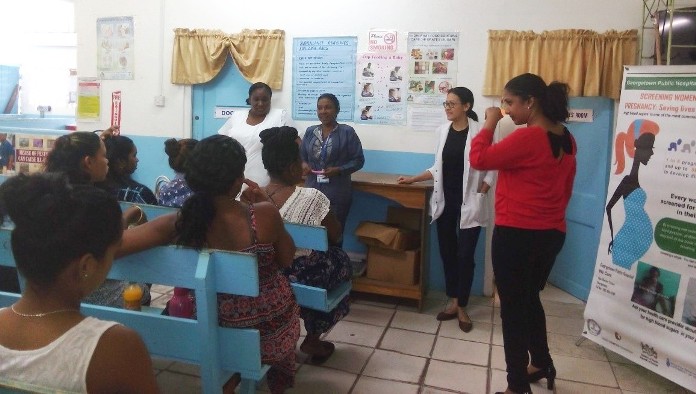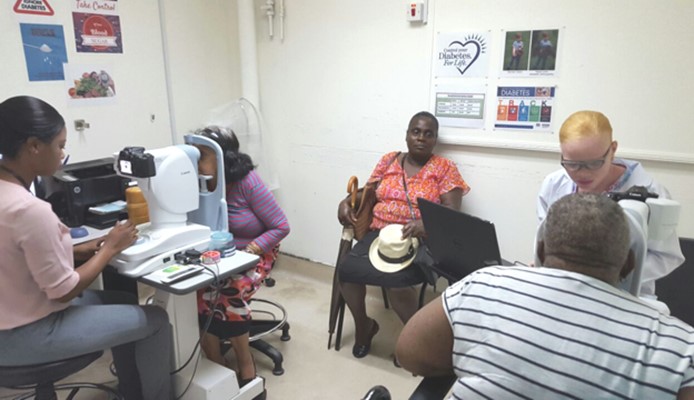Guyana Diabetes Care Project Concludes 9 Years of Successful International Diabetes Collaboration, Supported in Part by the BBDC International Diabetes Collaboration Program
January 6, 2020
Author: Dr. Brian Ostrow

OBSTETRICIANS AND DIETICIANS EDUCATE PREGNANT WOMEN ABOUT DIABETES IN PREGNANCY
On September 1, 2019, the Guyana Diabetes Care Project completed three years of international diabetes collaboration in Guyana, South America. The project received major funding of $303,821 USD from the World Diabetes Foundation as well as $90,000 CAD from the Banting & Best Diabetes Centre Sun Life Financial Impact Challenge Grant. The project was led by a team of Canadian physicians who partnered with the Ministry of Public Health (MOPH) with external partners including Orbis International and EyePACS, two eye care NGOs, and the WONDOOR global health program, which supports the training of obstetrics/gynecology residents in the country. It built on more than six years of prior collaboration which had developed diabetic foot centres throughout the country, trained hundreds of health care workers in diabetes and hypertension care, and introduced HbA1c testing. The current project had multiple components focussing on previously unmet needs in diabetes care, specifically diabetes eye health, diabetes in pregnancy, measuring diabetes prevalence, identifying previously undiagnosed persons, and expanding the database capacity of the public health care system.
Analyzing data obtained from Guyana’s first WHO STEPs survey in 2016, which included blood sugar and HbA1c measures, Canadian researchers estimated diabetes prevalence to be 14.7% of the adult population between 20 and 69 years. This is one of the highest rates in the Caribbean region. Women had higher rates than men, especially in the East Indian community. As well women living in rural areas were 7 times as likely to have diabetes as men living in rural areas. This information was presented at the 2019 International Diabetes Federation conference in Busan and has been submitted for publication.
It is generally recognized that for every person with diabetes there is another undiagnosed. Working with Guyanese colleagues, the Canadian team developed and validated a simple, 8 variable risk score that can be used to screen the population for undiagnosed diabetes. At the recommended cut-off, 43% is ruled out of having diabetes thereby decreasing the need for glycemic testing.
The clinical components of the project took place at the national referral hospital in Georgetown and were designed to be sustainable without the need for long-term external support. The Guyana Diabetic Retinopathy (DR) Centre was established with the purchase of two fundus cameras for screening and a laser unit for treatment of sight threatening DR. Three optometrists, newly graduated from the University of Guyana optometry course, were trained to perform retinal photography and grade the results. A number of Guyanese ophthalmologists were trained in laser therapy. Public education activities, including a TV ad on DR prevention and the production of over 30,000 DR flyers, were undertaken. By the end of the project almost 8000 persons with diabetes had been screened for DR. Reflecting previously unmet needs, almost one quarter of these had sight threatening DR and were referred for laser therapy. While there are recognized barriers to receiving DR treatment in both developed and developing countries, the over 90% success rate in achieving treatment of referred patients speaks to the integration of screening, counselling, referral and treatment which US optometrist, Dr. Jorge Cuadros from EyePACS, said was “unheard of” and “very impressive”. Orbis and EyePACS continue to work to expand diabetic eye care throughout the country.

OPTOMETRISTS PERFORM RETINAL PHOTOGRAPHY IN THE GUYANA DIABETES RETINOPATHY CENTRE.
Hyperglycemia in pregnancy (HIP) is another condition which increases maternal and neonatal morbidity and mortality. Global guidelines recommend glycemic testing of all pregnant women between 24 and 28 weeks gestation. The project instituted universal screening for all pregnant women at the high risk antenatal clinic of the hospital. Over 2200 women were screened; almost one quarter were found to have gestational diabetes and referred for treatment in a new program that included metformin and allowed for outpatient care. Pregnant women in two health centres were also screened for HIP and found to have a lower rate of about 5%. Guyanese obstetricians are now considering the most cost-effective plan for instituting screening throughout the country.
The project also supported the development of a web-based Guyana Health Information System (GHIS) through hiring a software developer and purchasing servers and networking cables. While this system showed initial promise, it’s uncertain if the MOPH will continue to support it.
International collaborations to improve health care capacity in low and middle income countries are complex undertakings. The real needs and intentions of the local authorities must be understood so that the designed interventions are truly appropriate and can be sustained over the long term. The experience of collaboration in Guyana has yielded important lessons and had significant positive impact on diabetes care in that country.
